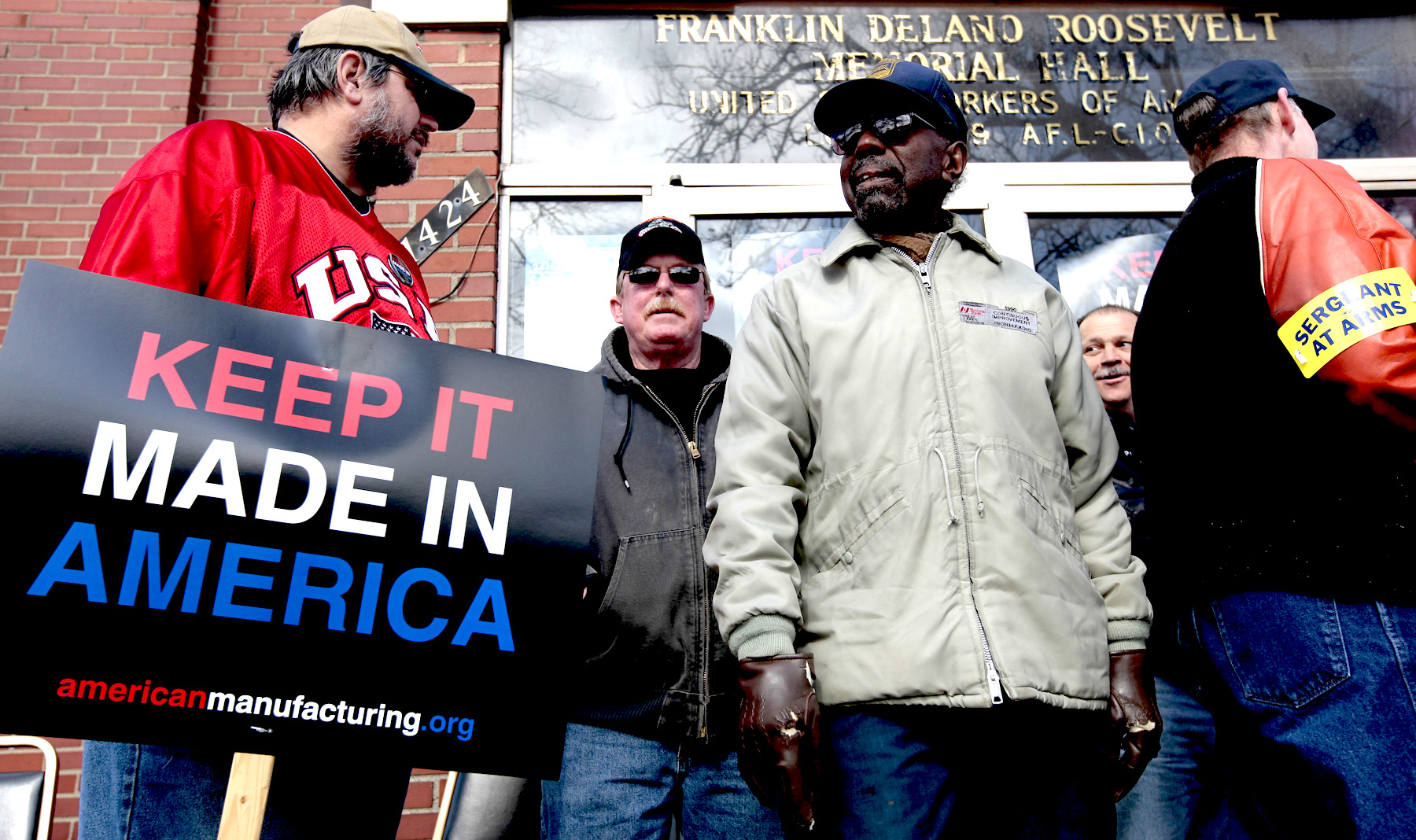- The disappearance of good manufacturing jobs is pushing middle-income workers down the economic ladder. Trade is partly to blame, but it is not the only factor contributing to this and the government needs to look at the bigger picture. The permanent loss of these jobs is contributing to a deterioration in quality of life, and political polarization.
During the 2016 presidential campaign, Republican candidate Donald Trump tapped into the anger over the loss of manufacturing and coal jobs. The culprit behind the misery of American workers, he said, was international trade. The message resonated, especially with male manufacturing workers who’d seen their job prospects dwindle over the past two decades. It’s true that middle-income jobs have been drying up, and even if the loss of those jobs is not just explained by trade and the rise of manufacturing in China or Mexico, trade is a factor. What’s also true is that this shortage of good manufacturing jobs is creating a kind of downward spiral. As middle-income workers are pushed down the economic ladder – going from relatively higher-wage factory jobs to, say, minimum-wage retail jobs – it’s making it harder for lower-income workers to pull themselves up. All this is turning up in measures of quality of life. Studies have linked trade shocks, like the emergence of China as a manufacturing base, to drops in marriage rates, upticks in risky behaviors like drug and alcohol abuse, and rising numbers of children living in impoverished, single-parent homes.
These trends have created a divide. While the majority of workers in America weren’t severely affected by trade, either way, a concentrated minority saw a reversal of fortunes. Those most hurt by trade have grown more politically polarized.
The Trump team has promised to make companies build factories at home and “hire American.” The solution, though, is more complicated. Trade is just one part of the picture, and the administration’s narrow focus doesn’t address the bigger economic shift that’s under way.
High-school graduates see a reversal of fortunes
American men have been dropping out of the workforce for over half a century. But even though participation has been falling for years, there’s another, more recent trend that stands out: People who only have a high-school diploma are particularly worse off today compared to 40 years ago.
The slump is particularly striking when comparing wages of high-school graduates to college graduates. In the 1970s, high-school graduates earned about 85% of what college graduates earned, but by about 2015 they earned about 55% of their college-educated counterparts.

Trade shocks
There isn't a single simple explanation for the shifting economic landscape, but since Trump and his team have tapped into something by focusing on trade, let's focus our attention on that as well.
The US economy has been transitioning from a manufacturing-based economy to a services-based one for decades, and employment in the former sector has dropped significantly. Since 1990, manufacturing employment has dropped by about a third.
The manufacturing sector saw particularly deep cuts after China's entry into the World Trade Organization (WTO) and the financial crisis, as shown below.

There's evidence that a concentrated minority of US workers saw significant drops in wage growth that could be correlated with the North American Free Trade Agreement (NAFTA), according to economists Shushanik Hakobyan and John McLaren. Blue-collar workers were more likely to be affected, college-educated workers less so, and executives saw some benefits.
"The most affected workers were college dropouts working in industries that depended heavily on tariff protections in place prior to NAFTA. These workers saw wage growth drop by as much as 17 percentage points relative to wage growth in unaffected industries," economist John McLaren said in an October interview with UVA Today.
"If you were a blue-collar worker at the end of the '90s and your wages are 17% lower than they could have been, that could be a disaster for your family."
McLaren added that it wasn't just the manufacturing industries that were affected, but entire towns that depended on those industries. Factory towns have grocery stores, bowling alleys, and public schools that all rely on industrial workers as customers.
The example McLaren gave was this: "A waitress working in a town that depends heavily on apparel manufacturing might miss out on wage growth, even though she does not work in an industry directly affected by trade."
Beyond the job market
What's particularly startling about the negative trade shocks is that they might've led to reverberations beyond the labor market. One study has suggested that changes in people's personal lives and health have been linked to those shocks.
In a paper published in July, David Autor, David Dorn, and Gordon Hanson found that negative trade shocks in manufacturing have hurt men's labor-market prospects, which then subsequently hurt the men's "marriage-market value" because of lower relative earnings and greater participation in risky and damaging behaviors such as alcohol and drug abuse.
Taking it a step further, they found that their lower numbers of "marriageable" men led to lower levels of marriage and lower fertility, but slightly higher fractions of children born to young and unwed mothers, and a jump in the number of children living in impoverished single-parent homes.
"We conclude that the declining employment and earnings opportunities faced by young (under 40) US males are a plausible contributor to the changing structure of marriage and childbirth in the United States," the authors wrote.

In an op-ed for the Financial Times published in July, Nobel Prize-winning economist Angus Deaton examined the differences between the US and the UK when it came to the opioid crisis.
He argued that one reason why middle-aged Americans in the US might have seen an uptick in deaths related to drug overdoses, suicides, and alcohol, while those in UK did not is the differences between both countries' wages. They've risen in the UK, adjusted for inflation, while they haven't in the US. In fact, median real wages in the UK were nearly 50% higher in 2008 than in 1988; median real wages in the US are basically the same today as they were in the early 1970s.
Politically polarized because of trade
The negative effects from trade seem to have spilled into the public arena. Areas that have been hit hardest by trade have become more politically polarized.
Economists David Autor, David Dorn, Gordon Hanson, and Kaveh Majlesi looked at the years from the first midterm election during the George W. Bush administration, in 2002, to the first midterm elections during Barack Obama's term, in 2010, and found empirical evidence linking the negative trade shock from China with an increase in electoral successes of non-centrist politicians and an increase in political polarization.
Crucially, it wasn't so much that the politicians who were already in office shifted their views away from the center, but rather that the electorate voted in new representatives who espoused more left- or right-leaning ideas.
"Trade-exposed districts initially in Republican hands become substantially more likely to elect a conservative Republican, while trade-exposed districts initially in Democratic hands become more likely to elect either a liberal or a conservative Republican," they wrote.
"Polarization is also evident when breaking down districts by race: trade-exposed locations with a majority white population are disproportionately likely to replace moderate legislators with conservative Republicans, whereas locations with a majority non-white population tend to replace moderates with liberal Democrats," they added.

Though the authors of the paper looked at 2002 to 2010, trade was big issue in the 2016 US presidential election. We saw a similar pattern with the emergence of nontraditional candidates such as Donald Trump and, to a lesser degree but still espousing a shift from center, Democratic candidate Bernie Sanders. Both pointed a finger at trade with China.
Even Hillary Clinton, more centrist than either Trump or Sanders, eventually abandoned support of the Trans-Pacific Partnership deal - after previously calling it the "gold standard" of trade agreements - ostensibly to address voters' concerns.
Trade shocks are of course not the sole variable affecting voters' decisions. The relationship of economics, race, social trends, institutions, and politics in the US is far too complex to be limited to a single study looking at just eight years - not to mention that sometimes those factors are interconnected.
America's problems aren't just about trade - and the solutions likely won't be either
Trade is not the only factor contributing to changes in America's economy.
Automation has eaten away at manufacturing jobs and will likely continue to do so. Some argue retail is the next sector to see a significant hollowing out, which is notable because the sector employs way more people than manufacturing does. Plus, the Great Recession slammed US industries across the board, and rural areas have still struggled to recover.
The Trump administration has essentially focused on the manufacturing jobs lost in the past two decades. And while they could theoretically help alleviate some short-term pain for some individuals by getting companies to built plants in the states, it's unclear how companies will adjust to that and it won't do anything to address the other issues like automation or the looming job losses in retail. Slapping tariffs on international partners wouldn't necessarily help either since many companies might find it cheaper to just automate rather than pay high US wages.
Against this backdrop, theoretical proposals across the political spectrum have been floated to address the hollowing out of middle-income and manufacturing jobs, though there's no consensus over what would work in practice.
Some have argued that school systems have to be adapted to the 21st century, instead of 19th-and-20th century model we have today, so that students will learn the necessary skills for the digital economy. Others have suggested that lowering taxes will encourage businesses to invest more and hire more people, and will encourage people to start small businesses.

There have been a number of big-picture ideas. Tech leaders have argued for universal basic income, under which all citizens would receive a standard amount of money each month to cover basic expenses like food and rent. Others have argued that if many other industries were more unionized (and therefore workers could bargain for higher wages as in manufacturing and construction), then they would have more appeal to workers. And still others argue we need a federal job-guarantee policy.
As an aside, several companies have started "mid-career internship" programs, which help people who spent a significant amount of time out of the workforce jump back in. Theoretically, a similar model can be applied for workers who were displaced mid-career so that they could relearn necessary skills amid shifting technological changes.

